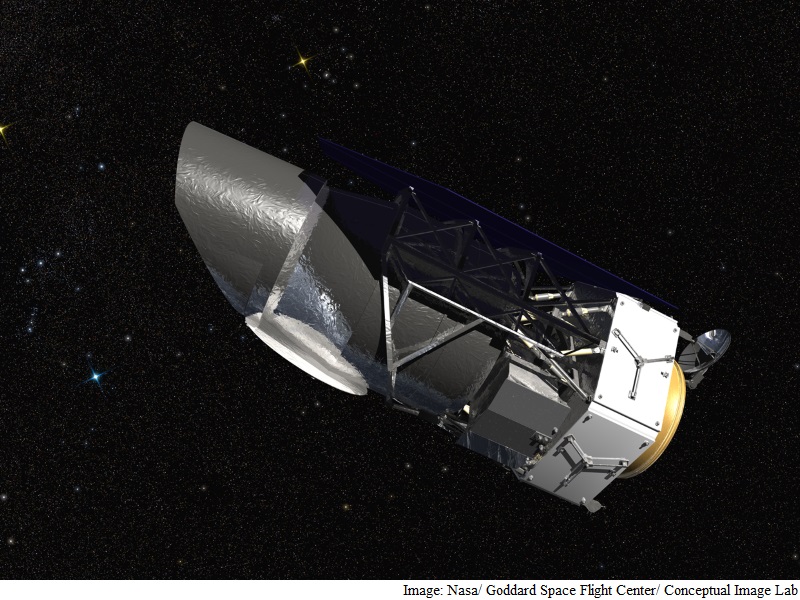- Home
- Science
- Science News
- Nasa's WFIRST Telescope to Unravel Secrets of Dark Energy, Dark Matter
Nasa's WFIRST Telescope to Unravel Secrets of Dark Energy, Dark Matter

Called the Wide Field Infrared Survey Telescope (WFIRST), it will help researchers unravel the secrets of dark energy and dark matter and explore the evolution of the universe.
Slated to be launched in the mid-2020s, the observatory will also discover new worlds outside our solar system and advance the search for worlds that could be suitable for life.
WFIRST is the agency's next major astrophysics observatory, following the launch of the James Webb Space Telescope in 2018.
"WFIRST has the potential to open our eyes to the wonders of the universe, much the same way Hubble has," said John Grunsfeld, associate administrator of Nasa's Science Mission Directorate in Washington, DC.
"This mission uniquely combines the ability to discover and characterise planets beyond our own solar system with the sensitivity and optics to look wide and deep into the universe in a quest to unravel the mysteries of dark energy and dark matter," he explained in a statement.
The observatory will survey large regions of the sky in near-infrared light to answer fundamental questions about the structure and evolution of the universe and expand our knowledge of planets beyond our solar system - known as exoplanets.
It will carry a Wide Field Instrument for surveys, and a Coronagraph Instrument designed to block the glare of individual stars and reveal the faint light of planets orbiting around them.
By blocking the light of the host star, the Coronagraph Instrument will enable detailed measurements of the chemical makeup of planetary atmospheres.
Comparing these data across many worlds will allow scientists to better understand the origin and physics of these atmospheres, and search for chemical signs of environments suitable for life.
"WFIRST is designed to address science areas identified as top priorities by the astronomical community," added Paul Hertz, director of Nasa's astrophysics division.
The telescope's sensitivity and wide view will enable a large-scale search for exoplanets by monitoring the brightness of millions of stars in the crowded central region of our galaxy.
By measuring the distances of thousands of supernovae, astronomers can map in detail how cosmic expansion has increased with time.
WFIRST also can precisely measure the shapes, positions and distances of millions of galaxies to track the distribution and growth of cosmic structures, including galaxy clusters and the dark matter accompanying them.
The observatory will begin operations after travelling to a gravitational balance point known as "Earth-Sun L2" which is located about one million miles from Earth in a direction directly opposite the Sun, Nasa said.
Catch the latest from the Consumer Electronics Show on Gadgets 360, at our CES 2026 hub.
Related Stories
- Samsung Galaxy Unpacked 2025
- ChatGPT
- Redmi Note 14 Pro+
- iPhone 16
- Apple Vision Pro
- Oneplus 12
- OnePlus Nord CE 3 Lite 5G
- iPhone 13
- Xiaomi 14 Pro
- Oppo Find N3
- Tecno Spark Go (2023)
- Realme V30
- Best Phones Under 25000
- Samsung Galaxy S24 Series
- Cryptocurrency
- iQoo 12
- Samsung Galaxy S24 Ultra
- Giottus
- Samsung Galaxy Z Flip 5
- Apple 'Scary Fast'
- Housefull 5
- GoPro Hero 12 Black Review
- Invincible Season 2
- JioGlass
- HD Ready TV
- Laptop Under 50000
- Smartwatch Under 10000
- Latest Mobile Phones
- Compare Phones
- OPPO Reno 15 Pro Max
- Honor Win RT
- Honor Win
- Xiaomi 17 Ultra Leica Edition
- Xiaomi 17 Ultra
- Huawei Nova 15
- Huawei Nova 15 Pro
- Huawei Nova 15 Ultra
- Asus ProArt P16
- MacBook Pro 14-inch (M5, 2025)
- OPPO Pad Air 5
- Huawei MatePad 11.5 (2026)
- Xiaomi Watch 5
- Huawei Watch 10th Anniversary Edition
- Acerpure Nitro Z Series 100-inch QLED TV
- Samsung 43 Inch LED Ultra HD (4K) Smart TV (UA43UE81AFULXL)
- Asus ROG Ally
- Nintendo Switch Lite
- Haier 1.6 Ton 5 Star Inverter Split AC (HSU19G-MZAID5BN-INV)
- Haier 1.6 Ton 5 Star Inverter Split AC (HSU19G-MZAIM5BN-INV)

















